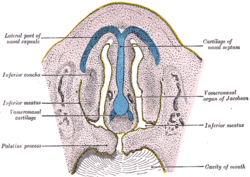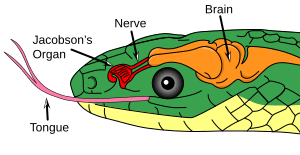Jacobson's organ facts for kids
Quick facts for kids Vomeronasal organ |
|
|---|---|
 |
|
| Frontal section of nasal cavities of a human embryo 28 mm. long (Vomeronasal organ of Jacobson labeled at right) | |
| Latin | organum vomeronasale |
| Gray's | subject #223 996 |
| Lymph | Node |
| Precursor | olfactory placode |
The Jacobson's organ is a special body part that helps many animals smell. It is also known as the vomeronasal organ or VNO. This organ was first found by Frederik Ruysch. Later, Ludwig Jacobson studied it more in 1813.
The VNO is mostly used to find pheromones. Pheromones are special chemicals. Animals release them to send messages to others of the same kind. These messages can be about finding a mate or warning others.
Scientists have debated if humans have a working VNO. Most studies suggest it shrinks during development before birth. Many genes needed for the VNO to work in animals do not work in humans. Humans do send chemical signals to each other. However, this does not mean our VNO is active.
How Animals Use the Vomeronasal Organ
Many animals have a working vomeronasal system. This includes all snakes and lizards. Many mammals also have it. These include mice, rats, elephants, cattle, dogs, cats, goats, pigs, giraffes, and bears.
- Salamanders often tap their noses on surfaces. This action likely helps them use their VNO.
- Snakes use this organ to find their prey. They stick out their tongue to collect scents. Then, they touch their tongue to the VNO opening.
- Primates like lemurs and lorises have a well-developed VNO. It is less developed in New World monkeys. It is very small in Old World monkeys and apes.
- Elephants use the tip of their trunk. They can pick up chemical smells with it. Then, they bring these smells to the VNO opening in their mouth.
- Painted turtles use their VNO to smell underwater. This helps them find food and stay safe.
Some mammals use a special face movement. This includes cats and hoofed animals like horses and pigs. This movement is called the Flehmen response. It helps them direct smells to their VNO. The animal lifts its head and wrinkles its nose. It also lifts its lips and stops breathing for a moment.
Studies show the VNO is very important for animals. It helps them with social interactions. It also plays a big role in their daily lives. The VNO is especially important for reproduction and social connections.
Images for kids
See also
 In Spanish: Órgano de Jacobson para niños
In Spanish: Órgano de Jacobson para niños




